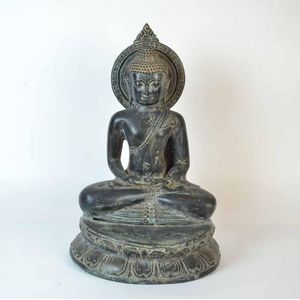Edo Period Gilt Wood Buddha Figure with Mandorla
You must be a subscriber, and be logged in to view price and dealer details.
Subscribe Now to view actual auction price for this item
When you subscribe, you have the option of setting the currency in which to display prices to $Au, $US, $NZ or Stg.
- Giltwood - Giltwood is used to describe a gold finish on furniture and other decorative wooden items, whereby a thin sheet of gold metal, called gold leaf, is applied to the surface for decorative purposes.
Unlike gilding, where the gold leaf is applied over a coating of gesso, with giltwood the gold leaf is applied direct to the surface, or over a coat of linseed oil gold leaf adhesive.
Most gold-finished mirrors will be gilded, whereas furniture with gold highlights will have the gold applied through the giltwood method. - Edo Period, Japan - The Edo period in Japan lasted from 1603 to 1868. During this time, Japan was ruled by the Tokugawa shogunate, a military government led by the Tokugawa family. The Edo period is characterized by a period of relative peace, stability, and economic growth, as well as by the development of a distinctive culture and society.
During the Edo period, the capital of Japan was moved from Kyoto to Edo (modern-day Tokyo), and the country became increasingly isolated from the rest of the world. The shogunate implemented strict policies to maintain control, including the restriction of foreign trade and travel. However, despite this isolation, the Edo period saw significant cultural and artistic development, including the emergence of the ukiyo-e woodblock print tradition, the growth of Kabuki theater, and the flourishing of a vibrant merchant culture.
The Edo period ended with the Meiji Restoration of 1868, which saw the collapse of the shogunate and the restoration of imperial rule.
This item has been included into following indexes:
Visually similar items

A Japanese gilded bronze Amitabha and a bronze washer, the Buddha standing on an ungilded lotus pedestal, the mandorla decorated with clouds and scrolling karakUSA, the washer cast with a head of a rabbit, 16 cm high (Buddha), 10.5 cm long (washer) (2)

A Tibetan seated Buddha statue patinated bronze metal. Height 44 cm

An unusual gilt ormolu timepiece in the form of a putti balancing an enamel watch, French, 19th century, clock maker la vallee, 20 cm high

A tall bronze seated Buddha, Chinese-Tibetan, 19th century, a full young face with elongated ears flicking out, wearing a simple unadorned, off the shoulder robe, hands in a meditating mudra, seated on single lotus petal plinth, above a plain platform, con
